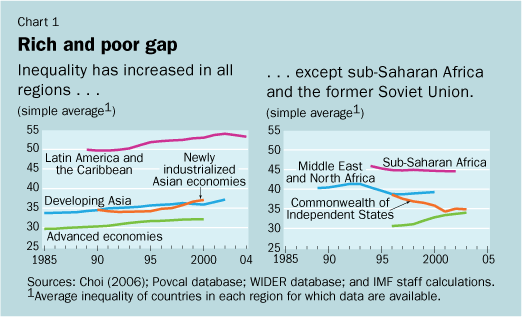
Typical street scene in Santa Ana, El Salvador. (Photo: iStock)
IMF Survey: Technology Widening Rich-Poor Gap
October 10, 2007
- New data show higher inequality in most regions in past two decades
- But per capita incomes are up for all population segments in nearly all regions
- Financial globalization has tended to increase inequality
The global economy has changed dramatically over the past two decades.

New income-, consumption-based data show inequality rose over past two decades in emerging Europe (photo: Dimitar Dilkoff/AFP)
GLOBALIZATION AND INEQUALITY
World trade has grown fivefold since 1980, and its share of world output has risen from 36 percent to 55 percent. Trade integration accelerated in the 1990s as the former communist countries entered the global trading system and developing countries in Asia dismantled trade barriers.
Key points
The issue: Is there a link between the increase in inequality seen in most countries and regions over the past two decades and the unprecedented integration of the world economy through the globalization of trade and finance?
The evidence: Technological advances have made the biggest contribution to widening income inequality across the world. The contribution of globalization is less important. Whereas trade globalization has helped reduce inequality, financial globalization—and foreign direct investment (FDI) in particular—has tended to increase it.
Policy considerations: Policy reforms to increase access to education and training would help ensure that the increase in incomes fostered by globalization is shared more equally. Policies that broaden the access of finance to the poor would also help, as would further trade liberalization.
The globalization of financial flows has also been rapid. Total cross-border financial assets more than doubled as a share of output between 1990 and 2004, from 58 percent of global GDP to 131 percent. The advanced economies continue to lead the trend in financial integration, but other regions are beginning to catch up.
How have these developments affected people's incomes and the gap between the rich and the poor within countries? A chapter of the IMF's 2007 October World Economic Outlook, entitled "Globalization and Inequality," offers some tentative answers.
Using newly available income- and consumption-based data, our research shows that inequality—as measured, for example, by the widely used Gini coefficient—has risen over the past two decades in most regions, such as developing Asia, emerging Europe, Latin America, and the newly industrialized economies of Asia, as well as in the advanced economies (see Chart 1). In contrast, it has declined in sub-Saharan Africa and the Commonwealth of Independent States.

Most people better off
Despite this observed rise in inequality, per capita incomes have risen across virtually all regions for all segments of the population, including the poorest. As a result, the poor are now better off in absolute terms, although in most cases incomes have risen at a faster pace for those who are already better off.
In sub-Saharan Africa and the former Soviet Union, the incomes of the poorest have actually risen faster than the incomes of other segments of the population. An exception is Latin America, where incomes of the poorest in some countries were adversely affected by economic crises, although they have since begun to recover.
What is contributing to the widening of the income gap within countries? Is globalization the main driving force, or have other factors such as skill-biased technological progress also contributed to rising inequality? Our analysis of the data yielded four main findings.
Technology is driving force
First, the main factor driving the recent increase in inequality across countries has been technological progress (see Chart 2). This factor alone explains most of the increase in the Gini coefficient from the early 1980s, supporting the view that new technology, in both advanced and developing countries, increases the premium on skills and substitutes for relatively low-skill inputs. Interestingly, among developing countries, the effect of technological progress is stronger in Asia than in Latin America, possibly reflecting the greater share of technology-intensive manufacturing in Asia.

Second, globalization has had a much smaller effect relative to technological change, reflecting the opposing influences of trade and financial globalization on inequality. Contrary to common belief, trade globalization has helped reduce inequality rather than increase it—particularly for agricultural exports, especially in developing countries where agriculture still employs a large share of the workforce.
Third, the net impact of tariff reduction played a positive role in reducing income inequalities. For advanced economies, rising imports from developing countries are associated with declining income inequality, presumably through the substitution of lower paying, low-end manufacturing jobs in advanced economies with higher-paying service sector jobs such as retailing and consumer finance.
Demand for skilled labor
Fourth, in contrast, FDI has had a mainly negative effect on the distribution of income. Higher FDI inflows have increased the demand for skilled labor in developing countries, whereas outward FDI in advanced economies has reduced the demand for relatively lower- skilled workers in these countries.
Given that financial globalization has expanded much more rapidly in advanced economies, while trade globalization has expanded more rapidly in developing economies, the net contribution of globalization to the increase in the Gini coefficient has been much more important in advanced countries. In developing countries, however, technology has been the main driving factor of the increase in the Gini, with globalization actually providing a small counterweight.
Several other factors have also had a relatively small impact on inequality. On the one hand, financial development has contributed to rising inequality because higher income groups have been better able to take advantage of the increased opportunities to borrow. On the other hand, greater access to education has supported an improved distribution of income. Better education enables a larger share of the population to acquire the skills required by the emerging global, knowledge-based economy and facilitates a shift in employment from agriculture to industry and services, thereby raising the agricultural sector's productivity relative to the average of the economy.
Education is key
What do these findings imply for policymakers as countries become increasingly integrated through trade and financial flows? Overall, technological progress and FDI are associated with higher growth, and their disequalizing effect reflects an increase in the returns from acquiring higher skills. The appropriate policy response is therefore not to suppress FDI or technological change, but to make increased access to education an important priority.
Better access to education would allow less-skilled and lower-income groups to capitalize on the opportunities from both technological progress and the ongoing process of globalization. Similarly, broadening access to finance, for instance by improving institutions that promote pro-poor lending, could help improve the overall distribution of income even as financial development broadly continues to support overall growth.
The positive role played by agricultural exports in terms of improving income distribution in developing countries suggests that policymakers should support growth in this sector. At the same time, better access to markets in advanced countries for agricultural exports from developing countries would support a more equal distribution of income in both developing and advanced economies.


